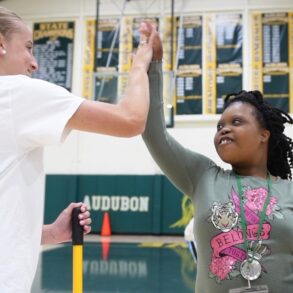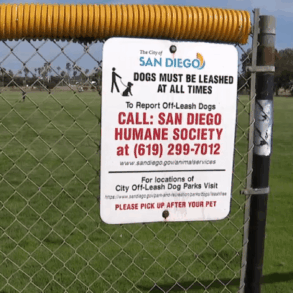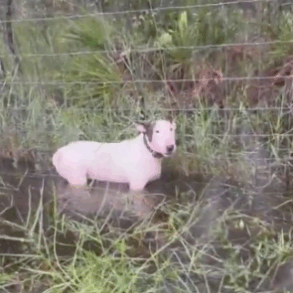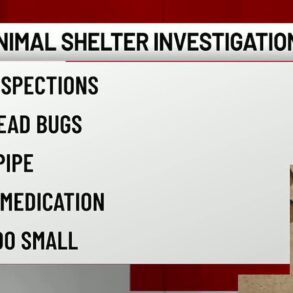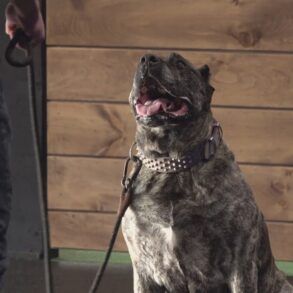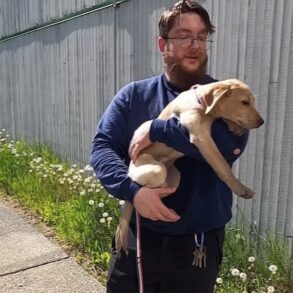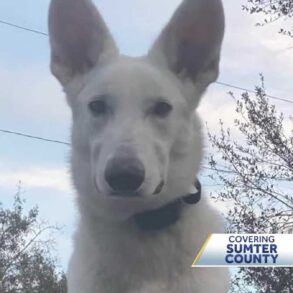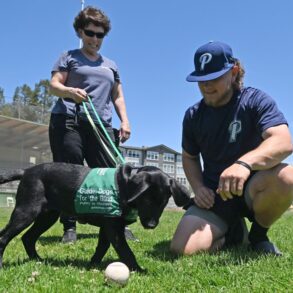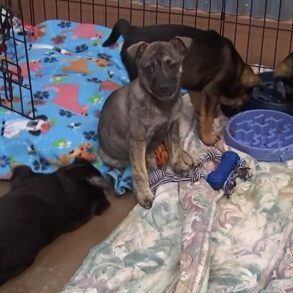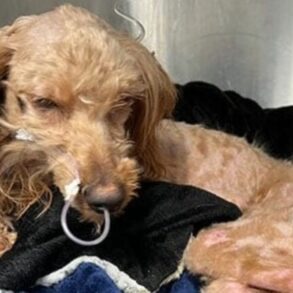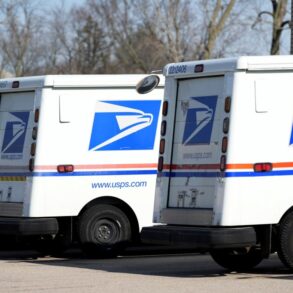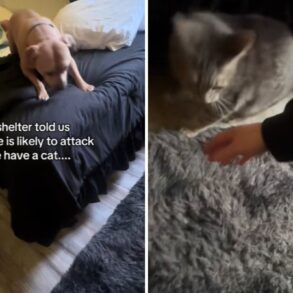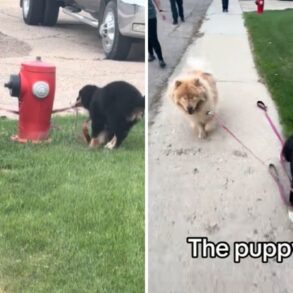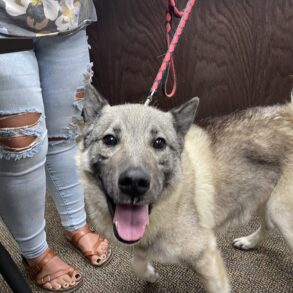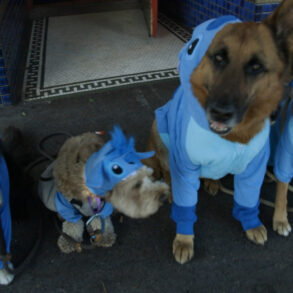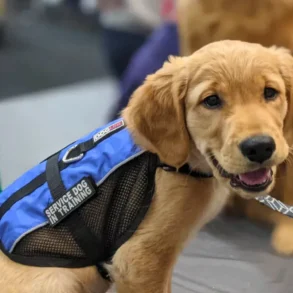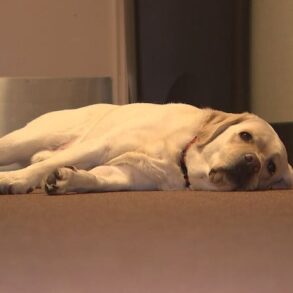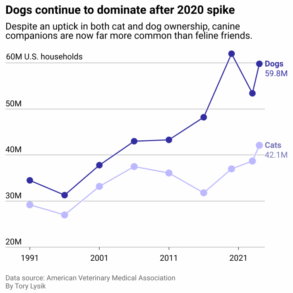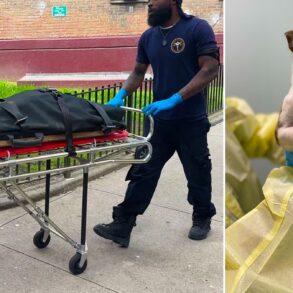
Welcome to Pet Peeves, a monthly series that aims to provide pet care solutions and expert advice for challenging scenarios that involve your beloved animal companions.
Walks in the rain when you have a dog are often unavoidable—and when the weather is warm, you might want to keep your pup out longer than you would the wintertime, which means more potential for mud and mess. Even if you have outdoor space that they can use, you still need to take measures to dry them off and keep muddy paw prints from getting all over your home. Not to mention that many pups can also be fearful of thunderstorms (or simply not want to do their business in the rain because they don’t like the feel of it), which can add another layer of stress for dog guardians during inclement weather.
Whether you’re a longtime dog owner dealing with the challenges of a senior pet in wet weather or have a new pup in the home, I’ve rounded up some expert tips (plus a few tried-and-true products) to help navigate rainy days with your pooch. I chatted with Dr. Andrew Findlaytor, chief veterinarian at Roo, about what to keep in mind when it comes to potential health issues that rainy weather can contribute to or exacerbate, as well as Juliana DeWillems, owner of JW Dog Training, for advice on keeping fearful pups comfortable during storms.
Keep Things Clean And Dry
While booties can be a big help in keeping your dog’s paws clean and dry when it rains, pups are notoriously finicky about their tolerance for them. I’ve used Pawz dog boots, which work well (if your dog keeps them on); Forbes Vetted baby and kids gear writer Alicia Betz also used these when her dog Silas had a cut and it needed to stay covered. “They stayed on his feet really well and kept them completely dry,” she says. If your pup isn’t a fan of boots, though, you might instead want to invest in a paw cleaner like the Mudbuster, which Betz swears by as well. It comes in three sizes and uses silicone bristles to remove any dirt. Just add a little water, twist gently around your dog’s paws and pat dry.
Raincoats can also help keep much of your dog’s body dry, and you don’t have to break the bank to find one that’s functional. This adorable doggie raincoat does an excellent job at protecting your pup in wet weather, it’s easy to take on and off, and it also features a hood—which, again, will come in handy so long as your dog doesn’t mind the feeling of it. Otherwise, Findlaytor recommends using an oversized umbrella for the most efficient rain coverage.
If you have a dog with touch sensitivity, DeWillems advises keeping a snuffle mat by the door and crumbling a bunch of treats into it to keep your pup busy while you wipe them off. (Here’s a video of this in action.) Another option, she notes, is to stick a suction lick mat on a door and smear peanut butter, cream cheese or any other treat on it while you dry their paws and body. (See what that looks like here.) “The underlying theme in both of these tricks is that your dog is kept occupied using an activity and treat that they love—high value treats can be key here,” she says. “This accomplishes a lot: Your dog stays in one place without restraint, their mouth is occupied so they can’t try to grab the towel and a positive association is being made.”
As far as keeping your home clean, you might want to consider a furniture cover to use on particularly wet days as an added layer of protection. I’m a big fan of Orvis’ products for pets; the brand’s couch covers, which come in three sizes and three colors, get rave reviews. (And if you’re traveling with your pup in the rain, a dog car seat cover is a must.)
Calm And Accommodate Fearful Pups
If your dog isn’t necessarily terrified of thunderstorms but simply won’t step outside the door when it’s raining (as someone who once had a 50-pound pit bull too scared to go out in even the slightest drizzle, I understand your pain), there are a few tactics you can try.
“I’ll tell owners, put your dog on a leash and still walk them out in the backyard, even though it sounds weird,” says Findlaytor. “I have seen dogs that, just having a leash on, it makes them feel like, ‘Hey you’re here with me, and I’m here with you, and and I’m okay to do my business.’” If you have a covered porch or patio area, you can also try using a patch of artificial or real grass. I have a subscription to DoggieLawn (it’s also available without a subscription via Chewy), which I use primarily for my senior arthritic dog so she doesn’t have to go up or down any steps when it’s raining. There are also plenty of artificial turf options to choose from. Otherwise, training your dog to use indoor pee pads might be necessary.
Things can be trickier if you’ve adopted an adult dog who’s already rather set in their ways—but if you have a puppy, “the best time to work on a dog’s fear around rain and rainy days is before it starts,” says DeWillems. “This is a part of puppy socialization that many pet parents don’t think about: Getting them used to going outside when it’s wet.” She advises using treats and playtime to introduce them to the feeling of wet grass, the feeling and sound of rain and even the sounds of thunder; she recommends using a recording where you can turn the volume way down to start. “As is the rule with all puppy socialization, exposure alone is not enough,” she says. “It has to be positive.”
Both Findlaytor and DeWillems note that the ThunderShirt can be effective for some pups, but it requires regular practice. “One thing that is important if you use a ThunderShirt is that you don’t only put it on your dog when there is a storm,” DeWillems says. “That’s a great way to teach your dog to worry any time they see the ThunderShirt. Put it randomly as much as you can outside of storms.” Most importantly, be present to help and comfort your dog. “Our dogs really need our support in these moments of fear and stress,” she adds.
For dogs whose fear of stormy weather is more severe (think: hiding, panting, pacing, trembling), you may want to talk with your veterinarian to see if anti-anxiety medication is an option for them. If your pup shows more mild fear, however, DeWillems recommends calming pheromones and supplements, particularly the bSerene line or Adaptil products. Some dogs may also respond well to sound-reducing ear covers, or you can turn on a white-noise machine or use a box fan to drown out the sound of the storm.
Protect Your Dog Against Health Risks
Rainy weather brings with it more potential for ear and skin infections, says Findlaytor, so it’s important to make sure not just their coat but also their ears are dried well after a rainy-day walk: “The more water dogs get in their ear, the more I tell owners, it’s almost like you’re watering little seeds of bacteria or yeast in your dog’s ear, so it’s easier and easier to get infections in there. Same goes with their skin.”
You also want to avoid having your dog drink from any puddles; parasites like Giardia, which cause diarrhea and an upset stomach, can lurk in there, and bacteria like Salmonella or E. coli may be present wherever there is runoff near deer. Leptospirosis is another disease transmitted by animals like deer, raccoon, squirrels and rats via their urine, which can be present in contaminated water; you may want to talk with your vet about vaccinating your dog against it. As a city dweller where rats are seemingly at every corner, I always make sure my pups are up to date on their lepto vaccination.
If you have a senior dog, Findlaytor advises avoiding slippery surfaces as much as possible. Walk on grass, gravel or any other stable surface. “You don’t realize it, but when they’re elderly, [many dogs are] almost doing a handstand. We’ll see that they have really big, kind of almost buff shoulders and really lean hips, because they don’t get as much arthritis in their shoulders and elbows as they do their hips and knees,” he says. “They kind of lean forward, so I tell people traction control is really important.” If your pup is on any kind of pain management for arthritis, he also recommends administering it in the evenings, after your walks are done, if possible—this way your dog doesn’t overdo it and is more aware of their own limits.
It’s also essential to make sure your pup’s paws are fully dried off before they come inside, to avoid any accidents on slippery floors. “The most dangerous time of your walk is right when you’re walking back in the door, if you have a slippery surface,” Findlaytor says. In general, yoga mats and runners are great to place around your home to provide more traction for senior and arthritic pets.
Findlaytor adds that for pups using wheelchairs, it’s especially important to keep them as dry as possible: “We found that when it rains, that nylon material kind of actually swells … so we’ll have a wheelchair that fits really well in dry conditions, but causes a lot of tummy rashes and abrasions when it’s wet.” He advises people to try everything they can not to get those wheelchairs wet, or, if they do, make sure to take a blow dryer and dry them out thoroughly.
Why Trust Forbes Vetted
The Forbes Vetted home team covers a wide range of pet products, from litter boxes to the best dog beds, as well as pet care topics, like how to make traveling with pets less stressful and tips for keeping your senior pet comfortable. We strive to help readers make smart, expert- and editor-backed purchases and decisions for their pets.
- Emmy Favilla, the author of this story and our monthly “Pet Peeves” column, is a 20-year media veteran who has spent the last eight years professionally testing and reviewing products, including a variety of pet-care items, from dog food delivery services to dog beds to toys. She has worked in a volunteer capacity with both cat and dog rescues and at New York City-based animal shelters for the greater part of the last 15 years, and has cared for dogs, cats and rabbits for most of her life.
- This piece was edited by home and kitchen editor Kelly O’Sullivan, a lifelong dog owner who has tested, written and reviewed many pet-related pieces for Forbes Vetted, including the best raw dog food and the best dog harnesses.
- We consulted Juliana DeWillems, KPA CTP, CDBC, a certified dog behavior consultant with over a decade of training experience. Based in the Washington, D.C. area, she’s the owner of and head trainer at JW Dog Training. DeWillems is also a member of the Karen Pryor Academy faculty, where she teaches the Dog Trainer Professional program. She previously worked on the behavior team at the Humane Rescue Alliance (formerly the Washington Humane Society) from 2015 to 2017.
- We also chatted with Andrew Findlaytor, DVM, chief veterinarian at Roo. He has extensive experience as a technician, associate, clinical researcher and relief veterinarian at over 80 different practices, including general practice, emergency, urgent care, rural community medicine and tertiary care facilities. A 2015 University of California–Davis, graduate, Dr. Findlaytor currently resides in Raleigh, North Carolina with his cat, Baymax.
Have a question for us? Email efavilla@forbes.com with the subject line “Pet Peeves.”
This post was originally published on this site be sure to check out more of their content.





